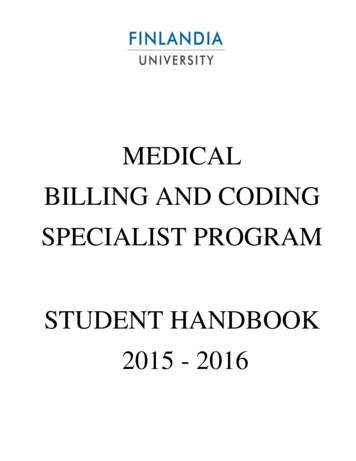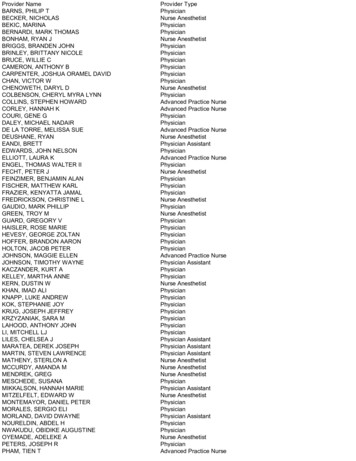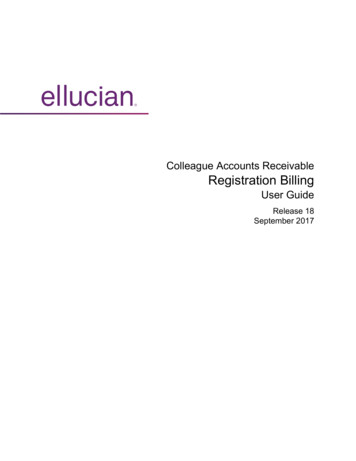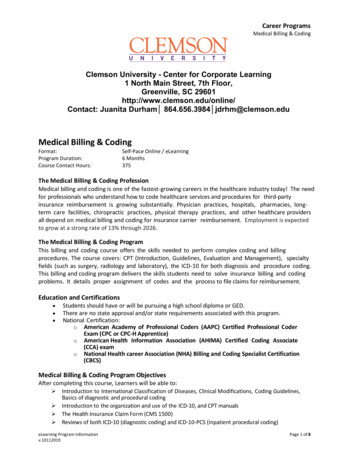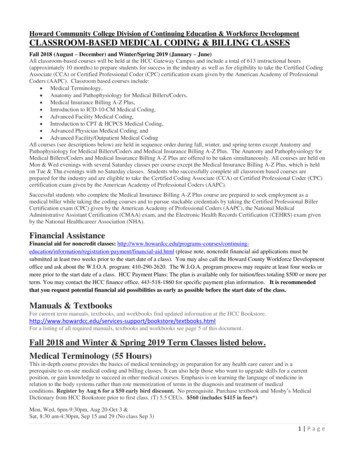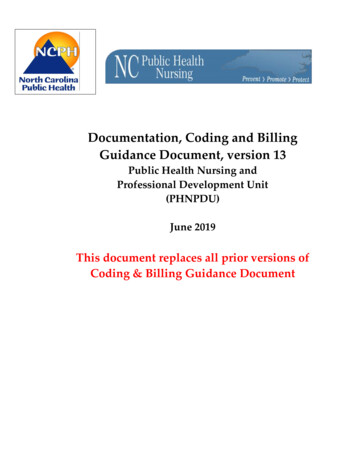
Transcription
PHYSICIAN OFFICE CODING ANDBILLING INFORMATION SHEET FOR KYPROLIS (CARFILZOMIB)FOR INJECTIONINDICATIONS KYPROLIS (carfilzomib) is indicated in combination with dexamethasone or with lenalidomide plus dexamethasone or withdaratumumab and dexamethasone for the treatment of adult patients with relapsed or refractory multiple myeloma who havereceived one to three lines of therapy. KYPROLIS is indicated as a single agent for the treatment of adult patients with relapsed or refractory multiple myeloma whohave received one or more lines of therapy.IMPORTANT SAFETY INFORMATION FOR KYPROLISCardiac Toxicities New onset or worsening of pre-existing cardiac failure (e.g., congestive heart failure, pulmonary edema, decreased ejectionfraction), cardiomyopathy, myocardial ischemia, and myocardial infarction including fatalities have occurred followingadministration of KYPROLIS. Some events occurred in patients with normal baseline ventricular function. Death due to cardiacarrest has occurred within one day of administration. Monitor patients for signs or symptoms of cardiac failure or ischemia. Evaluate promptly if cardiac toxicity is suspected. WithholdKYPROLIS for Grade 3 or 4 cardiac adverse reactions until recovery, and consider whether to restart at 1 dose level reductionbased on a benefit/risk assessment. While adequate hydration is required prior to each dose in Cycle 1, monitor all patients for evidence of volume overload, especiallypatients at risk for cardiac failure. Adjust total fluid intake as clinically appropriate. For patients 75 years, the risk of cardiac failure is increased. Patients with New York Heart Association Class III and IVheart failure, recent myocardial infarction, conduction abnormalities, angina, or arrhythmias may be at greater risk for cardiaccomplications and should have a comprehensive medical assessment prior to starting treatment with KYPROLIS and remain underclose follow-up with fluid management.Please see additional Important Safety Information for KYPROLIS on pages 6-7.
PHYSICIAN OFFICE CODING AND BILLING INFORMATION SHEETFOR KYPROLIS (CARFILZOMIB) FOR INJECTIONItemCoding Information (HCPCS/CPT/ICD)NotesKYPROLISJ9047, injection, carfilzomib, 1 mg 1KYPROLIS VIALS:KYPROLIS is supplied in single-dose vials containing 60 mg, 30 mg, or 10 mgof carfilzomib. 3The NDC numbers for KYPROLIS, in the 11-digit format, are as follows3:- 60-mg vial: 76075-0101-01- 30-mg vial: 76075-0102-01- 10-mg vial: 76075-0103-01MEDICARE MUE FOR KYPROLIS3-6:Under Medicare fee-for-service, J9047 has a Medically Unlikely Edit (MUE). Basedon the approved dosing range, Medicare will deny KYPROLIS claims billed formore than 160 units per date of service.- For example, at the BSA of up to 2.2 m2, the calculated dose for Kd70 is upto 154 mgJW MODIFIER7:For unused drug from single-use vials, some payers (eg, Medicare fee-for-service)require providers to report the JW modifier on a claim and to document thediscarded amount in the patient’s medical record.Administration96413, chemotherapy administration,IV infusion technique; up to 1 hour,single or initial substance/drug 2ORKYPROLIS can be administered as a 10-minute or 30-minute IV infusion,depending on the selected regimen1:- At the priming dose of 20 mg/m2 and at the therapeutic dose of 70 mg/m2once-weekly (DKd or Kd): KYPROLIS is administered as a 30-minute IV infusion.96409, chemotherapy administration,intravenous push technique (includinginfusions less than 15 minutes), singleor initial substance/drug 2- At the priming dose of 20 mg/m2 and at the therapeutic dose of 56 mg/m2twice-weekly (DKd, Kd, or K): KYPROLIS is administered as a 30-minute IV infusion.Office visitRelevant Evaluation and Management(E&M) code *,†See payer guidelines.Diagnosis/ConditionAppropriate diagnosis code(s) forpatient conditionICD-10-CM Example:C90.00, multiple myeloma not having achieved remissionC90.02, multiple myeloma in relapse 8- At the priming dose of 20 mg/m2 and at the therapeutic dose of 27 mg/m2twice-weekly (KRd or K): KYPROLIS is administered as a 10-minute IV infusion.* Bill relevant E&M code only if a separately identifiable E&M service is performed. Document accordingly.† Some payers, including Medicare, will not allow a Level 1 office visit to be billed with an injection/infusion code for the same date of service, and only allow for otherlevels when Modifier 25 is billed.The information provided in this Coding and Billing Information document is of a general nature and for informational purposesonly and is not intended to be a comprehensive list nor instructive. Coding and coverage policies change periodically and oftenwithout warning. The responsibility to determine coverage and reimbursement parameters, and appropriate coding for a particularpatient and/or procedure, is always the responsibility of the provider or physician. Healthcare providers should consult thepayer or Medicare contractor to determine which CPT code(s) are most appropriate for administration of Kyprolis . The codesprovided here are not an exhaustive list of drug administration services. Please refer to the CPT manual for a complete list ofdrug administration codes. The information provided in this section should in no way be considered a guarantee of coverage orreimbursement for any product or service.BSA body surface area; IV intravenous; Kd KYPROLIS (carfilzomib) and dexamethasone; KRd KYPROLIS lenalidomide and dexamethasone;DKd KYPROLIS daratumumab and dexamethasonePlease see Important Safety Information for KYPROLIS on pages 6-7.2
THE SAMPLE CMS 1500 FOR PHYSICIAN OFFICE —KYPROLIS AT 70 mg/m2 OR 56 mg/m2Physician Office Administration of KYPROLIS at the Therapeutic Dose of 70 mg/m2 or 56 mg/m2Doe, John Dxx xx xxDoe, John D5555 Any StreetAnytown01010ASxxx xxx-xxxxPRODUCT CODE (BOX 24D) AND SERVICE UNITS (BOX 24G)Document use of product with J9047, injection, carfilzomib, 1 mg.Report unit of service. For example, 120 units for J9047 corresponds to 120 mg of KYPROLIS.DIAGNOSIS CODE (BOX 21)Document appropriate diagnosis code(s)corresponding to patient’s diagnosis.Line A – primary diagnosis code.xxxx ofxxICD-10-CM codes include:ExamplesC90.00, multiple myeloma not havingachieved remissionC90.02, multiple myeloma in relapseNOTE: If required by payer to report unused drug from single-use vials (eg, Medicare*), reportKYPROLIS J-code on 2 line items, indicating: Units for the administered dose on the first line JW modifier† and units for the discarded amount on the second lineFor example, if two 60-mg vials of KYPROLIS are used to administer a calculated dose of 119 mg,119 units for the administered dose would be reported on the first line and JW modifier along with1 unit for the discarded dose would be reported on the second line, as follows:xx xx xx xx xx xx 11J9047xx xx xx xx xx xx 11J9047JWAxxx xx 119Axxx xx1* Applies to Medicare fee-for-service; requirements for Medicare Advantage may vary by plan. The JW modifier is only applied to the amount of drug that is discarded. If there is no discardedamount of KYPROLIS, it must be reported on a single line item without the JW modifier.†C90.02xx xx xx xx xx xx 11J9047Axxx xx 120xx xx xx xx xx xx 1196413Axxx xxNDC CODE(BOX 24A OR 24D)NOTE: Some payers may requireto document KYPROLIS NDCnumber in BOX 24A or 24D.Specific payer requirements forreporting NDC may vary.1DIAGNOSIS CODEPOINTER (BOX 24E)Specify diagnosis, from Box 21,relating to each CPT/HCPCS codelisted in Box 24D.These sample forms are intended as a reference for coding and billing for product and associated services. They are not intended to be directive; the useof the recommended codes does not guarantee reimbursement. Healthcare providers may deem other codes or policies more appropriate and shouldselect the coding options that most accurately reflect their internal system guidelines, payer requirements, practice patterns, and the services rendered.Healthcare providers are responsible for ensuring the accuracy and validity of all billing and claims for appropriate reimbursement.Please see Important Safety Information for KYPROLIS on pages 6-7.3
THE SAMPLE CMS 1500 FOR PHYSICIAN OFFICE —KYPROLIS AT 27 mg/m2Physician Office Administration of KYPROLIS at the Therapeutic Dose of 27 mg/m2Doe, John Dxx xx xxDoe, John D5555 Any StreetAnytown01010ASxxx xxx-xxxxPRODUCT CODE (BOX 24D) AND SERVICE UNITS (BOX 24G)Document use of product with J9047, injection, carfilzomib, 1 mg.Report unit of service. For example, 60 units for J9047 corresponds to 60 mg of KYPROLIS.DIAGNOSIS CODE (BOX 21)Document appropriate diagnosis code(s)corresponding to patient’s diagnosis.Line A – primary diagnosis code.xxxx ofxxICD-10-CM codes include:ExamplesC90.00, multiple myeloma not havingachieved remissionC90.02, multiple myeloma in relapse.NOTE: If required by payer to report unused drug from single-use vials (eg, Medicare*), reportKYPROLIS J-code on 2 line items, indicating: Units for the administered dose on the first line JW modifier† and units for the discarded amount on the second lineFor example, if one 60-mg vial of KYPROLIS is used to administer a calculated dose of 46 mg,46 units for the administered dose would be reported on the first line and JW modifier alongwith 14 units for the discarded dose would be reported on the second line, as follows:xx xx xx xx xx xx 11J9047xx xx xx xx xx xx 11J9047JWAxxx xx 46Axxx xx 14*Applies to Medicare fee-for-service; requirements for Medicare Advantage may vary by plan. The JW modifier is only applied to the amount of drug that is discarded. If there is no discardedamount of KYPROLIS, it must be reported on a single line item without the JW modifier.†C90.00xx xx xx xx xx xx 11J9047Axxxxx 60xx xx xx xx xx xx 1196409AxxxxxNDC CODE(BOX 24A OR 24D)NOTE: Some payers may requireto document KYPROLIS NDCnumber in BOX 24A or 24D.Specific payer requirements forreporting NDC may vary.1DIAGNOSIS CODEPOINTER (BOX 24E)Specify diagnosis, from Box 21,relating to each CPT/HCPCS codelisted in Box 24D.These sample forms are intended as a reference for coding and billing for product and associated services. They are not intended to be directive; the useof the recommended codes does not guarantee reimbursement. Healthcare providers may deem other codes or policies more appropriate and shouldselect the coding options that most accurately reflect their internal system guidelines, payer requirements, practice patterns, and the services rendered.Healthcare providers are responsible for ensuring the accuracy and validity of all billing and claims for appropriate reimbursement.Please see Important Safety Information for KYPROLIS on pages 6-7.4
RESOURCESFINANCIAL SUPPORT OPTIONS FOR ANY INSURANCE TYPEWhatever type of insurance your patients have—even if they have none—we can help you understand how their Amgen medicine may becovered, and refer them to programs that may be able to help them afford their medication, such as Amgen FIRST STEP . *For Eligible† Commercially Insured PatientsThe Amgen FIRST STEP program can help patients cover their out-of-pocket prescription costs,including deductible, co-insurance, or co-payment. 0 out-of-pocket for first dose or cycle As little as 5‡ out-of-pocket for subsequent doses or cycles, up to the brand program benefit maximum No income eligibility requirementFor Patients On Government Insurance Like MedicareAmgen Assist 360 can refer patients to independent nonprofit patient assistance programs that may be able to help them afford theco-pay costs for their prescribed medicine. §For Uninsured PatientsAmgen Safety Net Foundation, a nonprofit patient assistance program sponsored by Amgen, helps qualified patients access Amgenmedicines at no cost.Call 1-888-4ASSIST (1-888-427-7478) Monday–Friday, 9 am to 8 pm ETor visit WWW.AMGENASSIST360.COM/ENROLL* Resources include referrals to independent nonprofit patient assistance programs. Eligibility for resources provided by independent nonprofit patient assistanceprograms is based on the nonprofits’ criteria. Amgen has no control over these programs and provides referrals as a courtesy only.†T erms, conditions, and program maximums apply. This program is not open to patients receiving prescription reimbursement under any federal, state, orgovernment-funded healthcare program. Not valid where prohibited by law. Other restrictions may apply. Please see full Terms and Conditions atwww.AmgenFirstStep.com.‡ As little as 5 out-of-pocket cost for subsequent dose or cycle of KYPROLIS through Amgen FIRST STEP .§A mgen Assist 360 can refer patients to independent nonprofit patient assistance programs that may be able to help them afford the co-pay costs for theirprescribed medicine.References: 1. CMS. 2020 Alpha-Numeric HCPCS File. c-HCPCS-File. AccessedJuly 25, 2021. 2. American Medical Association. Current Procedural Terminology (CPT ) copyright 2020 American Medical Association. 2021. All rights reserved. 3. KYPROLIS (carfilzomib) prescribinginformation. Onyx Pharmaceuticals, Inc., an Amgen Inc. subsidiary. 4. CMS. Medically Unlikely Edits - Facility Outpatient Hospital Services MUE Table – Effective 07-01-2021. tCodInitEd/MUE.html. Accessed July 25, 2021. 5. CMS. Medically Unlikely Edits – Practitioner Services MUE Table – Effective 07-01-2021. tCodInitEd/MUE.html. Accessed July 25, 2021. 6. CMS. Medicare NCCI 2021 Coding Policy Manual. Chapter 1. tCodInitEd. AccessedJuly 25, 2021. 7. CMS. MLN Matters MM9603. s/MM9603.pdf. Accessed July 25, 2021.8. CMS. ICD-10-CM. 2021.Please see Important Safety Information for KYPROLIS on pages 6-7.5
IMPORTANT SAFETY INFORMATION FOR KYPROLISCardiac Toxicities New onset or worsening of pre-existing cardiac failure (e.g., congestive heart failure, pulmonary edema, decreased ejectionfraction), cardiomyopathy, myocardial ischemia, and myocardial infarction including fatalities have occurred followingadministration of KYPROLIS. Some events occurred in patients with normal baseline ventricular function. Death due to cardiacarrest has occurred within one day of administration. Monitor patients for signs or symptoms of cardiac failure or ischemia. Evaluate promptly if cardiac toxicity is suspected. WithholdKYPROLIS for Grade 3 or 4 cardiac adverse reactions until recovery, and consider whether to restart at 1 dose level reductionbased on a benefit/risk assessment. While adequate hydration is required prior to each dose in Cycle 1, monitor all patients for evidence of volume overload, especiallypatients at risk for cardiac failure. Adjust total fluid intake as clinically appropriate. For patients 75 years, the risk of cardiac failure is increased. Patients with New York Heart Association Class III and IVheart failure, recent myocardial infarction, conduction abnormalities, angina, or arrhythmias may be at greater risk for cardiaccomplications and should have a comprehensive medical assessment prior to starting treatment with KYPROLIS and remain underclose follow-up with fluid management.Acute Renal Failure Cases of acute renal failure, including some fatal renal failure events, and renal insufficiency (including renal failure) haveoccurred. Acute renal failure was reported more frequently in patients with advanced relapsed and refractory multiple myelomawho received KYPROLIS monotherapy. Monitor renal function with regular measurement of the serum creatinine and/or estimatedcreatinine clearance. Reduce or withhold dose as appropriate.Tumor Lysis Syndrome Cases of Tumor Lysis Syndrome (TLS), including fatal outcomes, have occurred. Patients with a high tumor burden should beconsidered at greater risk for TLS. Adequate hydration is required prior to each dose in Cycle 1, and in subsequent cycles asneeded. Consider uric acid lowering drugs in patients at risk for TLS. Monitor for evidence of TLS during treatment and managepromptly, and withhold until resolved.Pulmonary Toxicity Acute Respiratory Distress Syndrome (ARDS), acute respiratory failure, and acute diffuse infiltrative pulmonary disease such aspneumonitis and interstitial lung disease have occurred. Some events have been fatal. In the event of drug‐induced pulmonarytoxicity, discontinue KYPROLIS.Pulmonary Hypertension Pulmonary arterial hypertension (PAH) was reported. Evaluate with cardiac imaging and/or other tests as indicated. WithholdKYPROLIS for PAH until resolved or returned to baseline and consider whether to restart based on a benefit/risk assessment.Dyspnea Dyspnea was reported in patients treated with KYPROLIS. Evaluate dyspnea to exclude cardiopulmonary conditions includingcardiac failure and pulmonary syndromes. Stop KYPROLIS for Grade 3 or 4 dyspnea until resolved or returned to baseline.Consider whether to restart based on a benefit/risk assessment.Hypertension Hypertension, including hypertensive crisis and hypertensive emergency, has been observed, some fatal. Control hypertensionprior to starting KYPROLIS. Monitor blood pressure regularly in all patients. If hypertension cannot be adequately controlled,withhold KYPROLIS and evaluate. Consider whether to restart based on a benefit/risk assessment.Venous Thrombosis Venous thromboembolic events (including deep venous thrombosis and pulmonary embolism) have been observed. Providethromboprophylaxis for patients being treated with the combination of KYPROLIS with dexamethasone or with lenalidomide plusdexamethasone or with daratumumab and dexamethasone. The thromboprophylaxis regimen should be based on an assessmentof the patient’s underlying risks. For patients using hormonal contraception associated with a risk of thrombosis, consider an alternative method of effectivecontraception during treatment.Please see additional Important Safety Information for KYPROLIS on page 7.6
IMPORTANT SAFETY INFORMATION FOR KYPROLIS (cont’d)Infusion-Related Reactions Infusion-related reactions, including life‐threatening reactions, have occurred. Signs and symptoms include fever, chills, arthralgia,myalgia, facial flushing, facial edema, laryngeal edema, vomiting, weakness, shortness of breath, hypotension, syncope, chesttightness, or angina. These reactions can occur immediately following or up to 24 hours after administration. Premedicate withdexamethasone to reduce the incidence and severity of infusion-related reactions.Hemorrhage Fatal or serious cases of hemorrhage have been reported. Hemorrhagic events have included gastrointestinal, pulmonary, andintracranial hemorrhage and epistaxis. Promptly evaluate signs and symptoms of blood loss. Reduce or withhold dose as appropriate.Thrombocytopenia KYPROLIS causes thrombocytopenia with recovery to baseline platelet count usually by the start of the next cycle. Monitor plateletcounts frequently during treatment. Reduce or withhold dose as appropriate.Hepatic Toxicity and Hepatic Failure Cases of hepatic failure, including fatal cases, have occurred. KYPROLIS can cause increased serum transaminases. Monitor liverenzymes regularly regardless of baseline values. Reduce or withhold dose as appropriate.Thrombotic Microangiopathy Cases of thrombotic microangiopathy, including thrombotic thrombocytopenic purpura/hemolytic uremic syndrome (TTP/HUS),including fatal outcome, have occurred. Monitor for signs and symptoms of TTP/HUS. Discontinue if diagnosis is suspected. If thediagnosis of TTP/HUS is excluded, KYPROLIS may be restarted. The safety of reinitiating KYPROLIS is not known.Posterior Reversible Encephalopathy Syndrome (PRES) Cases of PRES have occurred in patients receiving KYPROLIS. If PRES is suspected, discontinue and evaluate with appropriateimaging. The safety of reinitiating KYPROLIS is not known.Progressive Multifocal Leukoencephalopathy (PML) Cases of PML, including fatal cases, have occurred. In addition to KYPROLIS, other contributory factors may include prioror concurrent use of immunosuppressive therapy. Consider PML in any patient with new onset of or changes in pre-existingneurological signs or symptoms. If PML is suspected, discontinue and initiate evaluation for PML including neurology consultation.Increased Fatal and Serious Toxicities in Combination with Melphalan and Prednisone in Newly DiagnosedTransplant-ineligible Patients In a clinical trial of transplant-ineligible patients with newly diagnosed multiple myeloma comparing KYPROLIS, melphalan,and prednisone (KMP) vs bortezomib, melphalan, and prednisone (VMP), a higher incidence of serious and fatal adversereactions was observed in patients in the KMP arm. KMP is not indicated for transplant-ineligible patients with newly diagnosedmultiple myeloma.Embryo-fetal Toxicity KYPROLIS can cause fetal harm when administered to a pregnant woman. Advise pregnant women of the potential risk to a fetus. Females of reproductive potential should use effective contraceptionduring treatment with KYPROLIS and for 6 months following the final dose. Males of reproductive potential should use effectivecontraception during treatment with KYPROLIS and for 3 months following the final dose.Adverse Reactions The most common adverse reactions in the combination therapy trials: anemia, diarrhea, fatigue, hypertension, pyrexia, upperrespiratory tract infection, thrombocytopenia, cough, dyspnea, and insomnia. The most common adverse reactions in monotherapy trials: anemia, fatigue, thrombocytopenia, nausea, pyrexia, dyspnea,diarrhea, headache, cough, edema peripheral.Please click here to see full Prescribing Information for KYPROLIS. 2021 Amgen Inc. All rights reserved. USA-171-81665 10-217
KYPROLIS J-code on 2 line items, indicating: Units for the administered dose on the first line †JW modifier and units for the discarded amount on the second line For example, if two 60-mg vials of KYPROLIS are used to administer a calculated dose of 119 mg,

